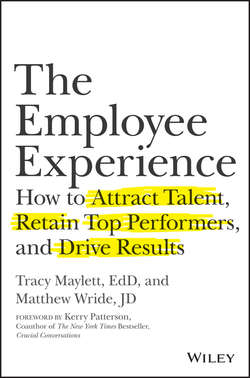Читать книгу The Employee Experience - Wride Matthew - Страница 13
На сайте Литреса книга снята с продажи.
PART I
Great Expectations
CHAPTER 1
You’re Digging in the Wrong Place
DEFINING THE EMPLOYEE EXPERIENCE
ОглавлениеWe’ve been clear that in order to create a superior CX, an organization needs to first take care of its EX. But what, exactly, is the “Employee Experience”?
Some mistakenly confuse the EX with popular terms like “Talent Management,” “Human Resources Development,” or “Employee Engagement.” While EX is certainly related to those terms, it’s not synonymous with them. EX is much broader in scope. So, for our purposes, here’s how we define EX:
The Employee Experience is the sum of perceptions employees have about their interactions with the organization in which they work.
In the introduction to this book, we mentioned a trend leading many HR executives (and even marketing departments) to take on titles like “Chief Employee Experience Officer.” On one hand, it’s wonderful to see because it makes us think they get it. But then we ask them to describe what “Employee Experience” means, and they bring out charts and models that are really describing the Employee Life Cycle (ELC).
While it certainly is a part of EX, the ELC is distinct, made up of all the steps or processes in which an employee participates during his or her relationship with the organization. An ELC is chronological and sequential, and assumes a beginning and an end. For example, the ELC includes important events and processes like recruiting, onboarding, employee development, promotion, and exit interviews. The ELC is an important part of the human resources process, because it takes into account the steps that occur from an employee’s first contact with the organization to the last interaction after termination. However, the ELC differs from the EX in two very significant ways: perceptions and expectations.
Consider this. Two friends, Ingvar and Edvar, start new jobs on the same day with the same company. For the first year, they are assigned to the same boss, work in the same manufacturing facility, and have similar job responsibilities. Their compensation is identical. In fact, nearly every step of the ELC is identical. Yet their EX is very different.
Ingvar has two children, both involved in football. When he joined the company, one of the things he found most attractive was that the company touted the importance of work-life balance, which was important to him because he wanted to support his children’s athletic events. Edvar is single. He’s all about the late-night party scene, so he finds getting to work before 9:00 in the morning (at least with a clear head) challenging, particularly on the nights he plays guitar in the band.
Fortunately for Ingvar, the company has some flexibility in how early employees leave in the afternoon, as long as they begin at 7:00 a.m. sharp and finish critical projects before heading out for the day. Ingvar finds this a real plus. Edvar, however, feels constrained by the 7:00 a.m. start time. It simply doesn’t meet his needs. He also thought that “work-life balance” meant he would have some flexibility that facilitated the “life” part of the equation as much as it did the “work” part. No such luck. In fact, last time he brought it up to his supervisor, he was told to “go read the policy manual.” He had also understood that he could be fast-tracked to a management position if he showed promise, which, in his mind, he clearly has. But he’s still in the same role he was in when he started with Ingvar over a year ago. He begins looking for new employment.
Two employees. Identical ELC experiences. Very different EXs.
EX depends largely on perception and expectations. (We’ll cover the expectations part in more depth in the next chapter.) The perception portion dictates the outcome of the experience. The EX is based on the employee’s perception of what it going on, not always on the reality of what occurs. This is why Ingvar and Edvar can have identical experiences yet their EXs can be vastly different:
EX = Experiences + Expectations + Perceptions
A positive EX, then, isn’t just a factor of what the company throws at the employee. Rather, it’s a result of how the employee perceives those experiences, and whether or not they meet her expectations.
Most organizations fail to understand this concept. They believe that creating a stellar EX is a matter of tossing out a few perks that they believe to be universally appealing (seriously, who doesn’t like Taco Tuesdays or a tube slide from the third floor down to the lobby?), then calling themselves “great places to work.” Yet their workers are still unhappy, and they move on to places where their EX is better aligned with what they’re looking for. After all, in today’s environment, employees have choices.
EGGHEAD ALERT!
Field Theory
Developed by psychologist Kurt Lewin, the concepts of “life space” and “field theory” are now important parts of social and organizational psychology. Lewin taught that behavior (B) is a function (f) of personal (P) and environmental (E) factors:
Lewin defined “life space” as a combination of the factors that influence an individual at any point in time. These factors could include life experience, memories, needs, personality, health, desires, and others. As these factors differ from person to person, each individual’s life space differs from that of another individual. The field, then, is the environment that exists in the individual’s (or group’s) mind. This field changes over time and with experiences. Field theory explains why two individuals (or groups) may encounter a nearly identical situation but may interpret that situation differently.
Конец ознакомительного фрагмента. Купить книгу
